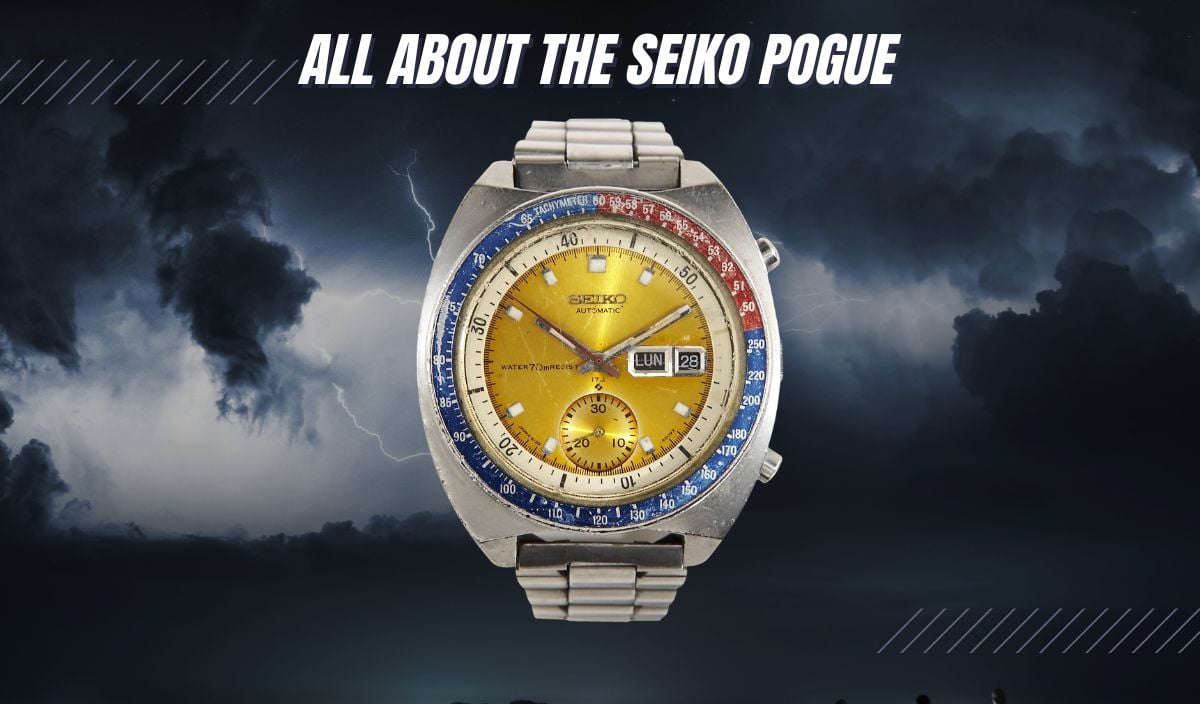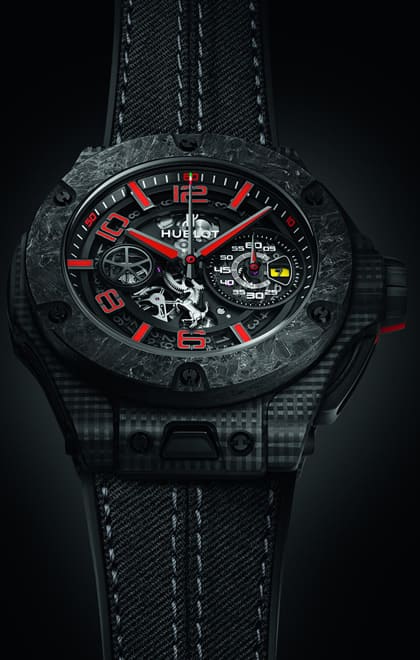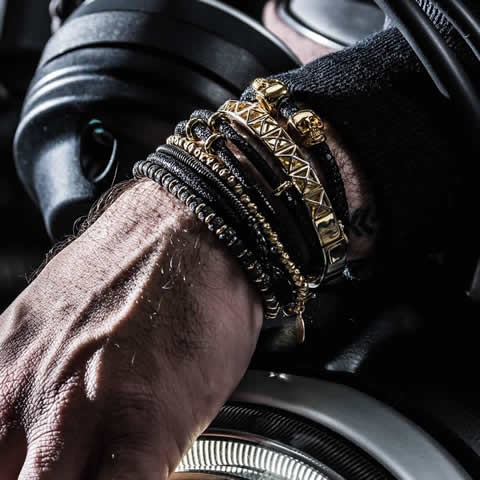
Seiko “Pogue”: The ICONIC First Automatic Space Chronograph!
Japan is famous for many things — technology, food, culture, nature, and many more. But what really flies under the radar is perhaps the creation of a certain watch brand named Seiko.
Thankfully for watch enthusiasts worldwide, we get to appreciate Seiko watches without needing to join a waitlist (looking at you, Rolex). With Seiko getting more popular among watch lovers, their passion leads to calling Seiko watches nicknames and rarely calling them by their actual names.
But I don’t blame them. Seiko’s watches’ names can be boring and long as most of them consist of random letters and numbers, like SNJ025P1, S23631, SRPE93K, and more. Instead of these meaningless numbers, they are named the Arnie, Tuna, and Turtle, respectively. Aren’t they a hundred times more memorable and interesting? Anyway, I think you get my point.
The Seiko Pogue (6139-6005) is no different, being nicknamed by Seiko lovers. In this topic, we will dive deeper into why it is named the Pogue. Why is it so special? And are there other “Pogues” out there?
Seiko 6139
It was in 1969 that Seiko released perhaps one of the world’s most important watches: the Seiko 6139. It came in different dial variations with the name 6139-600X, depending on the specific market.
It was also often called the “Speed Timer” as it features a chronograph function. At that time, it was considered a cutting-edge timepiece that included multiple advanced features in a single watch: a 30-minute chronograph recorder, a day-date indicator, and a tachymeter scale.
Competing For The Title
Putting the more technical stuff out of the way, let’s first discuss why it is so important. The Seiko 6139 was the first automatic chronograph wristwatch in the world. Well, arguably. Until this day, there is still a debate about which watch is the first automatic chronograph.
It was January 10th, 1969, when Zenith claimed the title of releasing their first automatic chronograph prototype watch, and they named the watch “El Primero” — meaning “The First” in Spanish.
To compete with this, four gargantuan watch companies: Dubois Dépraz, Breitling, Heuer, and Hamilton-Büren (you probably know the latter brands as TAG Heuer and Hamilton) called the Chronomatic group, worked hard together to develop their automatic chronograph watch.
On March 3, 1969, they released their prototype in a glamorous event, and a month later, pre-production samples were shown during the Basel Fair. Zenith was also at the fair but did not manage to compete with the Chronomatic group’s displays, as Zenith did not show that many samples during the event.
In May 1969, it was Seiko’s turn to claim the throne by releasing the 6139 “Speed Timer”. Initially launched exclusively in the Japanese market, its debut was eventually released to the rest of the world. Here’s where the word “arguably” comes into play.
To summarize the above according to the timeline:
Year 1969
January 10 – Zenith released El Primero, a prototype
March 3 – 4 big watch brands released the Chronomatic prototype
May – Seiko released the 6139 “Speed Timer”, serial production
So technically… Seiko claimed the throne for releasing the first automatic chronograph for someone who can actually buy and wear, and not just a prototype.
History and Origin of the Seiko “Pogue”
An American astronaut named Colonel William Pogue was assigned to a NASA space mission called “Skylab 4” in 1973. Six months before the mission, Col. Pogue needed to do pre-flight preparations to ensure its smooth execution, which included timing the spacecraft engine to measure when it would run out of power.
This was very critical for astronauts because, in the event of mechanical failure in space, they had to know the precise duration that allowed them to find a proper solution within that limited timeframe. It was a matter of life or death.
Col. Pogue clearly needed something reliable and competent for this task and decided to go watch shopping at the Ellington AFB Exchange in Texas. 13th June 1972 marked the birth of Seiko “Pogue”, when he stumbled upon the Seiko 6139-6005 and snagged it up for just $71—an absolute bargain if you ask me.
First Automatic Chronograph in Space
For many years, the Sinn 140 was on the throne for being the first automatic chronograph in space, worn by German astronaut Reinhard Furrer during his NASA “Spacelab D1” mission in 1985.
However, a new contender dethroned the Sinn 140, the Seiko 6139-6005. It was in 2007 when Col. Pogue was found wearing the Seiko Pogue during the NASA “Skylab 4” mission on 16 November 1973, making it the first automatic chronograph in space, 12 years before Reinhard wore his Sinn 140 to space.
Before the “Skylab 4” mission, all astronauts were only allowed to wear the Omega Speedmaster, being the only NASA-certified watch to be used in space. However, Col. Pogue was familiar with his trusty Seiko that he wore every day for the pre-flight preparation and decided to take his watch up to space.
He did this by secretly tucking his watch in his suit leg pocket without official approval from NASA. I guess you could say that he was over the moon with the purchase of the Seiko 6139-6005 and even decided to risk his career for this.
For most parts of the mission, he wore the Seiko on the left arm and the NASA-certified Omega Speedmaster on the right. This was extremely cool to see.
Col. Pogue wearing a Seiko, working in conjunction with Omega for the space mission. Or maybe, he decided to wear the Omega just for the photo but forgot to take off his Seiko “Pogue”. I guess no one really knows. What’s for certain is that Col.Pogue loved his Seiko “Pogue”.
Although he did not wear the watch during the EVA Spacewalk, I believe his Seiko 6139-6005 was always by his side for the rest of his mission which lasted almost 3 months and 84 days – until 8 February 1974.
Last Days of the True Seiko “Pogue”
Col. Pogue proudly wore his Seiko until his retirement in 2003. It was then auctioned off for $5,975 in 2008 at the Heritage Auctions, which was used to fund the Astronaut Scholarship Foundation. A photo of his Seiko 6139-6005 was later released on their website.
It was extremely worn out. The bezel was heavily scratched, and the colors were starting to fade. The crystal also had scratch marks all over it. The case and pushers were heavily damaged, where obvious scratches and chips can be seen.
What’s interesting is the bracelet of his Seiko as it was not original. Many believed that he swapped the actual bracelet for a new one, probably due to the torn condition of the original bracelet. But, I think he wanted to have a part of his faithful Seiko Pogue by his side.
Nevertheless, Col. Pogue wore his Seiko with the intention of using it, not collecting it, and that’s what watches are for. The Seiko 6139-6005 was not only Col. Pogue’s watch and tool but also his best companion.
The Seiko “Pogue” 6139-6005
Case
The case shape has these uniform and graceful curves on both sides, almost like the end of Batman’s logo design, indicating the bat’s wings. What’s unique is the aggressive tapering of the sharp lugs from the case itself, which elevates the look of the case. The case, at first glance, reminds me of a hovercraft because of the sharp tapering lugs that cause it to “float” on the wrist.
This defined look of the 6139-6005 is even more emphasized with the case size of 40mm, especially on a smaller wrist. For a watch in the 1970s, its case size would be considered big. However, with the help of its short 46mm lug-to-lug and the design of sharp lugs, the case does not feel bulky and sits comfortably on the wrist. With a 19mm lug width to hold the bracelet, it gives the case a balanced and symmetrical look.
The case is made from stainless steel with a beautiful satin finish to ensure long-lasting, reliable performance. Stainless steel, being a more durable and harder material with anti-corrosive and scratch-resistant qualities, is the perfect choice for a watch like the Seiko 6139-6005. You’d never know if someone will take it on an audacious adventure like going into space.
Caseback
The caseback is simple – the Seiko logo, markings of “Waterproof” or “Water Resistant”, depending on the year of production, the serial number, and also the model number of your watch. Interestingly, watches with “Waterproof” markings were manufactured between 1969 to February 1970. However, in response to the general consensus among watch manufacturers, Seiko subsequently adopted the term “Water Resistant” instead.
The caseback is also made of tough stainless steel to help maintain water resistance of 70m and was essential in protecting the watch from potential damages like dust and rust. Being an older watch with a chronograph function, 70m water resistance was respectable during that time.
Bracelet
Matching with the case, also made with stainless steel, is the “H-link” bracelet with thick and polished end links. The folding clasp is also easy to operate and is comfortable on the wrist. However, the construction of the bracelet wasn’t great as it wobbles easily and does not have the best of finishes. But for $71 (at that time), it will suffice.
Crystal
Unlike most high-end watches, unfortunately, the Seiko Pogue has a Hardlex crystal instead of a more scratch-resistant sapphire crystal. But Hardlex crystal has its upsides too. Made from Seiko’s own factory, this crystal can withstand minor collisions and features anti-reflective properties—an advantage that sapphire crystals lack.
This means you can properly read the time (or enjoy the amazing dial) on your Seiko Pogue, no matter the lighting conditions. Its affordability compared to a sapphire crystal also convincingly justifies the pricing of the Seiko Pogue.
Bezel
The Seiko Pogue has a Pepsi color scheme tachymeter, with about a quarter of bright red starting from 12 and a vibrant blue on the rest of the bezel. The striking contrast between red and blue enables wearers to effortlessly use the tachymeter function to measure time, speed, and distance.
The markings on it are also clear, crisp, and precise, with the use of white fonts for the text. This, combined with the Pepsi color scheme, really brings the watch alive, giving it a splash of sportiness and certainly adding points to the fun meter.
What adds an extra layer of fascination to the Seiko Pogue is a bright yellow inner bezel that rotates! Photos of Col. Pogue’s watch showed a white inner bezel instead of yellow.
Knowing that none of the Seiko 6139 models had a white-colored inner bezel, it was later discovered the originally yellow inner bezel would gradually turn white from constant UV exposure, which just proves that Col. Pogue truly loved his Seiko 6139-6005 and wore it so often.
The inner bezel is actually a rotating indicator ring with black-colored 60 minutes markings, allowing the wearer to measure minutes more accurately. Wonder how it rotates? Keep reading to find out.
Crown
The Seiko Pogue definitely has the coolest crown function in all watches I’ve seen. But let’s talk aesthetics first. The crown has no special emblem, guards, or other fancy-looking additions. Nestled seamlessly within the case at 3 o’clock, it does not protrude out like traditional crowns, making it barely visible from the front view.
Now let’s talk functions. To use the chronograph function, two pushers are located at 2 and 5, protruding from the case. To start and stop recording, push the top pusher, and the red second hand will sweep/stop; to reset, simply push the bottom pusher after stopping the recording, and the red second hand will snap back to its original position (at 12).
To adjust the time, simply pull the crown into the first position and rotate. Nothing special, but here comes. To rotate the inner bezel, you just need to rotate the crown at its original position in either a clockwise or anti-clockwise direction, and the inner bezel will rotate accordingly.
Still not special enough? Take a look at this. To change the date, you push the crown inwards, and to change the day, you push the crown inwards, harder, almost like acting as a button. Yes, there may be more efficient ways, but it is extremely cool to find brands coming up with ingenious ideas and implementing them into watches.
To this day, I have not seen any other watch with this function to change the day and date, and I hope one day Seiko brings this back (or I could just get a Seiko Pogue).
Dial
Striking is an understatement for Seiko Pogue’s dial. I really want to give credit to Seiko’s design department for having the guts to try something new, especially for their first automatic chronograph. The dial has a dazzling yellow-gold dial that almost reminds me of honey under beaming sunlight with its sun-ray finish.
The color contrast of this yellow-gold dial with the Pepsi-colored bezel really shows off the look of the Seiko Pogue, almost like it constantly has a spotlight on it. Such bold use of three primary colors definitely isn’t for everyone, and it is a design that you either hate or love and thankfully, I’m in the “love” category.
With its chronograph function, the dial has a yellow-gold sub-dial at 6 that is able to record up to 30 minutes. The black-toned numbers and texts make it easy to read for wearers. Another feature is the day-date windows, located at 3 framed with silver boxes, black background, and white font (red on Sunday), giving it a more well-defined look.
The dial also has simple squared-baton indices and baton-styled hour and minute hands in a shiny silver color. Giving a contrasted look, the second hands and the sub-dial chronograph hands are colored in deep red. Most importantly, all hands and indices are coated with Seiko’s luminous tech with the use of Tritium.
To complete the look, what makes the Seiko Pogue unique, is the information written on the dial. It features a “SEIKO AUTOMATIC” at 12, “WATER70mRESIST” at 9 and just slightly below the middle of the dial (between the minute and hour hands and the 30-minute sub-dial), placed the markings of the words “17J” and the Suwa logo.
Movement
The Seiko 6139-6005 runs on the 6139B automatic movement, an improvement over the original movement of 6139A that was used for the first 6139-600X batches. Featuring a frequency of 21,600 vibrations per hour, a respectable thickness of just 7.1mm for a chronograph movement with day and date functions, and a 45 hours power reserve.
With this being a vintage watch, we can properly assess its reliability and reviews from its wearers from all these years. Upon research, many did not find any problems with the movement and only needed minimal services to keep it functioning. Keep in mind this watch was released 53 years ago! No wonder Seiko is often praised and seen as one of the most robust and reliable watchmakers in the world.
Other Variations of the Seiko “Pogue”
Seiko 6139-6002
Let’s address the elephant in the room. Most people mistook the 6139-6002 as the true “Pogue” instead of the 6139-6005. The difference is not obvious, but it is noticeable.
Similar to the 6005, the 6002 also has a vibrant yellow-gold dial, but the information on the dial is different. On the 12, it has the word “SEIKO Chronograph Automatic” (instead of SEIKO Automatic); there are no “WATER 70m RESIST” markings on the 9; and there are no “17J” and no Suwa symbol.
There have been several changes to the Seiko 6139-600X models throughout its production years, especially the writings on the dial. Let’s discuss what has changed throughout the years.
Information Changes On The Dial
1969 – early 1970: The words “WATER 70M PROOF at 9 o’clock, “Chronograph Automatic” at 12 for JDM (Japanese Domestic Market) models, and “Automatic” for non-JDM models. The caseback also features the “WATERPROOF” marking.
These are very rare to acquire because it was only released for a short period of time, making them more desirable for watch collectors. Late 1970 – 1971: The markings changed to “WATER 70m RESIST” due to a law that required manufacturers to include the markings of water resistance instead. Markings on the caseback also changed to “WATER RESIST” (used until April/May 1970) or “WATER RESISTANT”.
1972: Markings of “WATER 70m RESIST” on the dial were completely removed but maintained the “WATER RESISTANT” wording on the case back.
Dial Colors
The reference numbers of specific Seiko 6139-600X models do not directly correlate to different dial colors, as they can sometimes mean releases for different regions or at different times.
All dial colors also went through different phases of information changes, as mentioned above. Hence, in this article, we focus only on the other dial colors of the Seiko 6139-600X models to prevent further confusion.
Blue dial: Nicknamed the “Cevert” because it was worn by the famous French F1 racer François Cevert, who later died in an unfortunate car crash in 1973. It was also worn by Pink Floyd’s Nick Mason, which adds to the cool factor.
Interestingly, the blue dial was also released as a JDM model with “Speed-Timer” replacing “Chronograph Automatic” at 12 o’clock, and “5 SPORTS WATER 70 PROOF” (later changed to just “5 Sports” in 1975) at 9. This dial variation also comes with a black inner bezel.
Gold dial: Most well-known dial for the Seiko Pogue (6139-6005) and the 6139-6002. Most people also associate the 6139-6002 with the Seiko Pogue as well due to its similarities with the 6139-6005.
Silver dial: Possibly the rarest dial variation and is highly sought after by watch collectors. This also comes with a black inner bezel.
Teal dial: Another really rare dial variation, and it is speculated that this watch was only produced for 2 months. It’s nicknamed the “Sunrise” due to its red bar markings at the 6 o’clock sub-dial. This also has a unique “Speed-Timer” text at 9 o’clock written in red and a “Seiko 5 Sports” logo at 12.
Final Thoughts
What an adventure that the Seiko Pogue has had, been to possibly the hardest place to go to for any human being, let alone watch. Hopefully, the Seiko Pogue is resting well and in a better place. Perhaps it’s for the best so that other watches can rest well, too, from jealousy.
It’s easy to understand why Seiko has one of the biggest “cult” groups in the world, and I can clearly say that I’m proud to be one.
About Exquisite Timepieces
Established in 1998, Exquisite Timepieces is your one-stop shop for all things luxury watches! We are an authorized dealer for 60+ luxury watch brands including Omega, Hublot, Seiko, & Longines! We are proud to showcase one of the world’s largest pre-owned watch collections, including renowned brands like Rolex and Patek Philippe. Check out our brand new watch arrivals here and popular pre-owned listings here.








